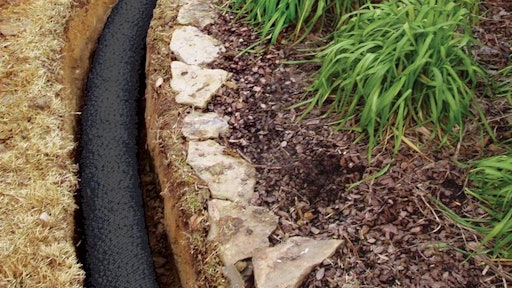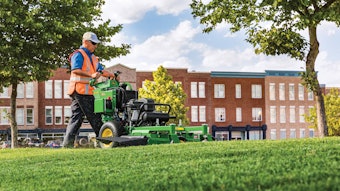
Without proper drainage, landscapes and yards can quickly turn into ponds. Often, these instant ponds are fed by gutter systems that take water off a building’s roof. Most homes and businesses stop with the rain gutter’s downspouts leading straight to the ground, where all the water comes off the roof and pours to just one point, where it can collect. It’s the most common drainage problem, and it’s also the easiest to fix by extending downspouts away from a house or building. Ideally, the extensions should take rainwater at least 10 feet away from a structure.
Other standing water problems, however, can be much more complex. Whether it’s a splashy walkway, driveway or patio, a soggy backyard, water pooling near a home’s foundation or in planter areas, or runoff from a neighbor’s property, it’s important for property owners to address any water problems before they become big, expensive ones.
The human health costs of poor drainage on a property can be significant. Poorly drained runoff from roofs can enter basements or flow inside homes and businesses through foundational cracks or leaks where it can warp floorboards and turn finished rooms into disastrous and mildewy messes that can attract insects and rodents. Outside, inadequate or non-existent drainage from gutter downspouts can also create standing water that can harbor breeding spots for mosquitoes that carry West Nile virus, Zika virus and heartworms.
The financial costs of poor drainage can be substantial. Drying a basement of toxic water due to poor drainage ranges from $1,000 to $10,000, according to the U.S. National Flood Insurance Program. Repairing damage to a building’s foundation as a result of poor drainage can range anywhere from $3,500 to $25,000, according to the National Association of Realtors. Replacing a landscape washed away from heavy rains averages $7,500 and can run as high as $30,000, according to HomeAdvisor. Further, soggy, poorly graded ground spells certain doom for lawns, shrubs and plants, and a major drainage problem or foundation damage can reduce a building’s value by 10–15 percent, according to the National Association of Realtors.
Many people might think solving a stubborn drainage problem will be difficult and costly, or that they’ll end up with an ugly drainage ditch on their property It is possible to eliminate standing water cost-effectively and attractively by building one of the most popular and common solutions for getting rid of standing water, a French drain.
What is a French drain?
A French drain is a gravel-filled trench that includes a slotted pipe or a gravel-free alternative containing a perforated pipe surrounded by a polystyrene aggregate enclosed in a geotextile mesh; the aggregate increases void space for improved water flow and greater storage while offering greater structural integrity than gravel, resisting compaction.
 Engineered flood channels increase void space, creating improved water flow and greater storage. The lightweight expanded polystryene aggregate offers structural integrity and resists compaction.
Engineered flood channels increase void space, creating improved water flow and greater storage. The lightweight expanded polystryene aggregate offers structural integrity and resists compaction.
Ideal for landscapes and lawns, hardscape patios and driveways, retaining walls, and foundation and footing perimeters, French drains are used to direct surface water or groundwater away from a specific area toward the lowest point. The water is then collected in the perforated pipe, running at the base of the drain, and directed away from the home or landscape and toward a more suitable area for daylighting or infiltration. French drains differ from typical surface drains because they collect water over the entire length of the drain instead of one particular spot.
Remember water always seeks out the lowest point it can reach along the easiest path, readily moving into empty pockets in loose soil. That’s the secret to a French drain: It provides a reliably easy path, creating a sunken channel that encourages water to percolate out of the surrounding soil and flow along a smooth course. Leveraging gravity is essential for a French drain to function properly, as it first forces water down from the surface and out of saturated soil, then pulls it along the downward-sloping pipe to the desired discharge point.
Where and when to install at French Drain
An easy way to site a French drain is to watch where water pools — especially if it sits for hours or days — after a rain. Some of the most common drainage problems are:
Flooding in a yard: If heavy rains has left a yard with an unwanted water feature or the spring thaw has saturated a property, a French drain can help. Placing a French drain in this wet region allows the drain to collect unwanted water and redirect it to a safer location.
Damage to an outdoor patio: Patios are a great source of pride and a meeting place for family and friends, but excess water can damage the area, deteriorate the pavers, and also create a breeding ground for mosquitoes. A French drain can work as a shield, collecting water before it reaches the patio and diverting it away. This will also eliminate the standing water that mosquitoes need to breed.
Runoff from a neighboring property: Water from an uphill neighbor’s property can drain towards and puddle next to a home or business. Whether the water is coming from a single location or along the length of the neighboring property, installing an underground drainage system provides protection from costly water damage.
Water near driveways, walkways and planter areas: Water pooling on driveways reducing its functionality can potentially flood a garage. Water pooling on walkways causes concrete staining and slip hazards. Water pooling in planter areas next to a home or business can create muddy areas and cause damage to foundations.
Key considerations before starting
There are many factors to consider before installing a French drain. Slope is essential, as a downhill course must be downhill enough to keep water running along to its intended destination. Generally, a French drain should drop at least one percent in depth for every 100 feet of length.
Other key issues to consider include:
- French drain depth: About 8 inches to 2 feet deep should be sufficient for many water-diverting projects, though related systems, such as those built around foundations and sub-ground living spaces, as well as the bases of retaining walls, may be deeper.
- French drain aggregate: The size of the gravel used can vary from pea gravel to larger pieces of river rock. If aggregate of different sizes is used, smaller pieces usually go closer to the pipe, while larger pieces sit closer to and on the surface.
- French drain pipe length: This really depends on a project’s specific elements. Of course, the pipe should be long enough to carry water from the underground areas where it collects to an end point, where it daylights.
- French drain flow: Slope is a big factor in maintaining a free flow of water, as is the aggregate placement and surrounding fabric to prevent debris from clogging the pipe.
Installing a French drain
Here’s a step-by-step guide to installing a French drain on a property.
1. Decide on the best location
Determining the best location depends on where the problem areas are located, nearby elevation, and the condition of the soil. Use the design tips above to help with siting to ensure proper slope, depth, and more. When it comes to the soil, sandy soil located in an out-of-the way area is preferred.
2. Prepare to dig
City codes must be considered, and you need to be aware of how your project will affect neighboring properties. This is also an ideal time to contact the local utility company to have any underground lines marked before digging begins. Once you start digging, your drain depth will need to be anywhere from eight inches to two feet, depending on your needs and available options.
3. Measure the grading
This process begins by pounding two stakes into the ground to mark the dimensions of the trench. A taut string is tied between them, allowing for easy grade measurements as the digging process begins. Regular measuring checks will be performed throughout the process.
4. Dig a trench across the slope
Digging the trench is the most labor-intensive portion of the project and as it is being dug, constant grading measurements are necessary. The width of the trench will depend on how large the drainage problem is. Smaller drainage problems can be handled with a trench that is 5 to 6 inches wide, while larger problems will require a larger trench.
5. Add the fabric
Once the trench has been dug, it will be lined with landscape fabric, and then additional gravel is added. This fabric prevents dirt from mixing with the gravel and promotes water percolation. Once the fabric has been applied, a light load of gravel is shoveled over the top so the corners of the fabric can be wrapped around this gravel, holding it in place.
6. Add pipe
Place a slotted or perforated pipe at the bottom of the trench. The pipe needs to be directed towards an outlet to drain away from the home or business.
7. Fill with gravel
The drain is nearly complete. Now the gravel of whatever size you choose will be shoveled in. Once the gravel is in, top it with another layer of landscape fabric and then cover it with top soil and new sod.
For more information about French drains, visit the NDS Home Drainage Center, a free online resource that provides a wealth of information for identifying drainage problems, selecting solutions and downloading installation instructions. NDS also offers a free “Stormwater Drainage Tools” mobile app that simply and quickly calculates stormwater runoff and determines requirements for implementing a variety of drainage solutions.


























